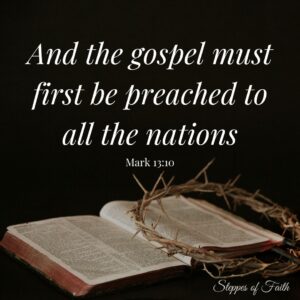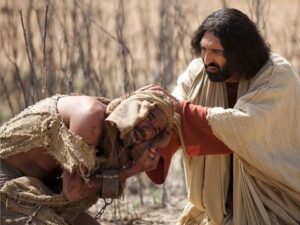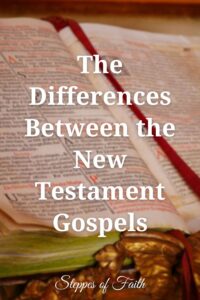
“And the gospel must first be preached to all the nations.” (Mark 13:10)
The New Testament gospels (“good news,” “tidings”) tell us about Jesus, His life, and His ministry. Many of the events described in each book overlap. However, some events and parables are found in only one gospel, while the other gospels describe something completely different or omit it entirely. One book may be very detailed, but another is not.
Why are the gospels different? It is important to know the distinctions, and we can learn more by examining each author’s intended audience and overall message. More importantly, how the gospels complement each other help us better understand who Jesus is and why He came to us.
Here we examine each of the four gospels and how they differ, with one very special.
The Book of Matthew
Originally named Levi, Matthew was a Jewish man who worked for the Roman government collecting taxes. The Jews heavily despised such men. But Jesus, in His grace, overlooked Levi’s circumstances and saw his potential for something more meaningful.
“After these things, [Jesus] went out and saw a tax collector named Levi sitting at the tax office. And He said to him, ‘Follow Me.’ So, he left all, rose up, and followed Him.” (Luke 5:27-28)
Exactly when God changed Levi’s name to Matthew is unknown, but we can observe that his call to discipleship is the same in the books of Matthew (9:9), Mark (2:14), and Luke (5:27-28). God often changed someone’s name after an encounter with Him. Abram became Abraham, Sarai became Sarah, Jacob became Israel, Simon became Peter, and Saul became Paul. Levi’s name changed to Matthew is not unusual.
As a Jew, Matthew wrote his gospel to a Jewish audience, primarily men familiar with Torah. As such, Matthew refers more than 60 times to the Old Testament to prove that Jesus is the promised Messiah and the fulfillment of Old Testament promises.
Further, Matthew refers to Jewish customs without needing to explain them (unlike the other gospels, Mark 7:3; John 19:40), and he frequently calls Jesus the “Son of David,” a term the Jews understand (1:1; 9:27; 12:23; 15:22; 20:30; 21:9,15; 22:42,45). He also shows sensitivity to Jewish conscience about God’s name by refraining from using the phrase “kingdom of God” and instead calling it the “kingdom of heaven” 32 times (although the book of John avoids both almost entirely, instead using “eternal life”).
Matthew’s gospel again appeals to a male-dominated audience when he details Jesus’ lineage. The Jewish faith typically follows a family through the male side, which is why Matthew lists Joseph’s family bloodline. In doing so, Matthew’s readers can positively trace Abraham, the father of the Jews, to Jesus, thus pushing Jesus’ credibility as the Messiah.
The apostle Matthew goes to great lengths (longer than any of the other gospels) to prove that Jesus is the fulfillment of Old Testament prophecy that He is the Messiah and the Son of God.
The Gospel of Mark
Unlike Matthew, Mark (aka John Mark) was not one of Jesus’ twelve disciples. However, scripture suggests he may have been (or not) a part of a group that followed Jesus wherever He went.
[READ MORE: Who Was Mark in the Bible?]
Mark’s intended audience was Roman believers, especially Gentiles. His gospel message presents Jesus as the suffering Servant of the Lord (10:45), portraying Him as a man of action, one of service and sacrifice for His people. The focus is on His activities rather than His teachings. This type of man was worthy of respect by Greeks, especially a soldier.
To further connect with Greek readers, Mark translates Aramaic terms (see 3:17; 5:41; 7:11,34, 10:46; 14:36; 15:22,34), and he sometimes uses Latin instead of Greek expressions (5:9; 6:27; 12:15,42; 15:16,39). He explains Jewish customs (unlike Matthew, see 7:3,4; 14:12; 15:42), omits Jesus’ Jewish genealogy and the entire story of His birth and baptism, and makes only a few references to the Old Testament, Pharisees, and Sadducees. Gentiles would not understand such topics, so Mark deems them irrelevant.
Mark also leaves out the lengthy discourses found in the other gospels and only offers brief excerpts instead. He simply presents Jesus’ teachings in snippets to help his readers get the gist of the teaching without losing their interest.
Finally, to help solidify a connection to a Roman Gentile audience, Mark mentions that Simon the Cyrene is the father of Rufus (15:21). Romans would have been very familiar with Simon since he was a prominent member of the Roman church (see Romans 16:13).
Overall, the book of Mark is all about understanding Jesus’ humanity, and Mark accomplishes it well. He adequately highlights Jesus’ emotions (1:41; 3:5; 6:34; 8:12; 9:36) and His limitations as the Son of God clothed in humanity (4:38; 7:33,34; 8:12; 9:36; 10:13-16; 11:12; 13:32).
In understanding Jesus’ human side, his Gentile audience can better connect to Him personally and understand all He bravely endured to bring us the hope of salvation without religious culture getting in the way.

The Gospel of Luke
Like Mark, Luke was not an eyewitness to Jesus’ ministry, which means he relied on others who were.
Though he declares at the beginning of his gospel that he had a “perfect understanding of all things from the very first (v.3),” his words are misinterpreted in modern translation. Because he was not present at any of the significant events of Jesus’s life, this verse is better translated that he investigated and researched them to their fullest extent.
Luke was a highly educated Gentile physician (Colossians 4:14) and one of the apostle Paul’s mission partners. His background explains why his intended audience was the Greeks. As such, Luke preferred Greek terminology instead of Hebrew. While the other gospel writers used Jewish terms such as “Abba,” “rabbi,” and “hosanna,” Luke either omits them or uses a Greek equivalent to help make a connection between the Jewish and Greek cultures.
Luke’s overall message is to prove to his audience that Jesus is the Messiah. His literary style recounts Jesus’ life more like a historian than a disciple. He routinely provides precise times and locations of certain events (e.g., Jesus’ birth in chapter two) to help provide historical context. Such detail was an important element in Greek society.
To further help convey his gospel message, Luke includes several narratives that are significantly different from the other gospels.
Luke’s Distinctive Details
He is the only one to provide the unusual circumstances leading to John the Baptist’s birth (ch.1), the announcement of Jesus’ birth to Mary (ch.1) and the later visiting shepherds (ch.2), and Simeon’s and Anna’s blessing offerings at the temple at the time of Jesus’ dedication (ch.2). Such details contribute to the credibility of Jesus’ claim as the Messiah and Son of God.
Luke also highlights Jesus’ unwavering compassion for the outcasts of Jewish society, especially women. He notably features Mary, Elizabeth, the prophetess Anna, and the presence of women at Jesus’ resurrection to show their central role in Jesus’ life and ministry.
With Mary, in particular, Luke traces Jesus’ genealogy through her side of the family instead of Joseph’s, as Matthew did, proving that, no matter which bloodline we consider, Jesus is a descendant of Abraham and King David, as the Scriptures foretold.
Luke also devotes ten chapters to the account of Jesus’ final journey to Jerusalem, far more than the other gospel writers. Some say this section is the heart of Luke’s gospel, which shows the overarching theme of Jesus’ advancement to the cross and His universal invitation to salvation for everyone.
The Very Unique Gospel of John
The book of the apostle John is extraordinarily unique from the synoptic gospels.
Throughout his entire writing, John aims to prove that Jesus is the Son of God, the promised Messiah, and to reassure his readers of the Lord’s gift of eternal life (1:12).
From the very first verse, he expresses that he intends to prove that Jesus is the Word of God and He has always existed. The remainder of his gospel emphasizes Jesus’ love and grace and that He has come to bring salvation to anyone who accepts Him. For this reason, the book of John is often informally called “the love gospel.”
John makes it very clear his gospel is for anyone who will read it, though many contend it is primarily for believing Christians (especially second-generation Christians in the first century). In chapter 20, John spells it out for us.
“But these are written that you may believe that Jesus is the Christ, the Son of God, and that believing you may have life in His name.” (John 20:31)
The keyword in this verse is “believe.” John uses it over 100 times, far more than the other gospel writers because belief in Christ is the only way to eternal life. John also generously uses the words “life” and “signs” to emphasize a theme of salvation through Christ.
Another purpose of John’s gospel was to stop the early church from giving in to false teachings. Many Christians began believing that Jesus was only a spirit and never had a physical body. This doctrine is often called Gnosis or Gnosticism. It may be why John begins and ends his gospel by talking about Jesus’ body and often mentions Him physically touching others.

John’s Literary Usage
John uses several literary devices in his gospel.
First, as the most theological of the gospel writers, John uses antithetical dualism to describe Jesus. We see many examples of Jesus as light and darkness, love and hate, life and death, above and below, and freedom and slavery (1:4,5,12,13; 3:16-21; 12:44-46, 15:17-20). The other gospel writers do not use such a device.
Secondly, John uses extended dialogues and allegories rather than parables. In fact, John’s gospel contains no parables. Though he hints at parables found in the other gospels (such as 15:1-8, “the vine and the branches”), he only presents them as part of a narrative and not stand-alone stories.
John is careful to separate himself from the events he describes. As the last written gospel, he presents the events in a reflective, more thoughtful approach rather than a descriptive “in the moment” approach like the synoptic gospels.
Finally, John mainly structures his writing specifically around these eight miracles (“signs”) to reinforce the truth of Jesus’ identity. Some are found only in John’s book.
- Water turned into wine (2:1-11)
- Healing of a royal official’s son (4:46-54)
- Healing of the lame man (5:1-18)
- Feeding the 5,000 (6:1-15)
- Walking on water (6:16-21)
- Healing of the blind man (9:1-41)
- Raising Lazarus from the dead (11:1-57)
- The disciples catching a massive number of fish after Jesus’ resurrection (21:6-11)
Though Luke was an obviously talented writer, John’s creative narrative style enables us to get a more intimate sense of what it means to be a follower of Christ.
John’s Exclusive Information
As if John’s gospel was not unique enough, he offers several pieces of information in his eyewitness account not found in the other gospels.
First, the other gospel writers pick up Jesus’ ministry in Galilee, but John goes back much further. He supplies earlier information about His work in Judea (ch.2) and Samaria (ch.3). He explains why Jesus suddenly instructed the disciples to cross the Sea of Galilee after feeding the 5,000 (ch.6), and he dedicates more of Jesus’ teachings about the Holy Spirit (14:16,17,26; 16:7-14). John is also the only one to mention Jesus’ prior visits to Jerusalem before His triumphal entry.
Like Matthew, John refers to himself in his writing, except he does not call himself John but the one “whom Jesus loved (13:23; 19:26; 20:2; 21:7,20).” Despite Jesus nicknaming John and his brother, James, the “sons of thunder (Mark 3:17),” the way John refers to himself reflects his intimate relationship with Jesus in a way the other gospel writers do not.
Perhaps most unique is that John is the only one to mention Jesus’ conversations with key individuals.
He describes Jesus’ secret discussions with both Nicodemus (ch.3) and the Samaritan woman at the well (ch.4). He also depicts the woman caught in adultery (ch.8), the healing of a blind man (ch.9), the raising of Lazarus (ch.11), washing the disciples’ feet (ch.13), and His special resurrection appearance to Thomas (ch.20).
Finally, John is the only gospel writer to present the seven “I AM” statements.
“I am the bread of life.” (6:35)
“I am the light of the world. (8:12)
“I am the door.” (10:7,9)
“I am the good shepherd.” (10:11,14)
“I am the resurrection and the life.” (11:25)It
“I am the way, the truth, and the life.” (14:6)
“I am the true vine.” (15:1,5)
Notably, one of the statements—that of the good shepherd—is a direct reference to the Old Testament (Psalm 23:1, 80:1; Jeremiah 31:10; Ezekiel 34:23). It helps potential Jewish readers make a connection and understand that Jesus is the true Messiah.

The Gospels and Jesus’ Heart
John presents many unique moments in Jesus’ life in a more intimate way than the other gospel writers. However, he surprisingly leaves out many significant events found in the other gospels.
He does not include the nativity story, Satan’s temptation in the desert, the Sermon on the Mount, the Lord’s Prayer, the transfiguration, and the institution of the Lord’s Supper. And he never mentions casting out demons.
And, because he focuses on the realized work of Christ (as opposed to future work), John makes almost no references to the rapture or Jesus’ second coming. But, as we know, John later wrote more extensively about the end times than anyone else in the Bible when he wrote the book of Revelation.
The writers of the New Testament gospels perfectly and holistically describe our Lord Jesus Christ and His ministry. Though each has unique features, they beautifully interconnect and complement each other to provide a larger picture of who He is and why He came to offer us a path to salvation.
Through Matthew, Mark, Luke, and John’s Holy Spirit-inspired writings, we get a glimpse into not only Jesus’ inner circle but also His heart and overwhelming desire to save us. It does not matter from which perspective we approach Him—Jewish, Roman, Greek, or Christian—we all have intimate access to the Good News and the hope of eternal life with Him.

For God so adored the World that he gave his main Child, that whoever has faith in him shouldn’t die yet have timeless life.
I think you mean His only Son.